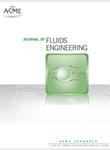Journal


Journal of Fluids Engineering
Archives Papers: 363
American Society of Mechanical Engineers
Please choose volume & issue:
-
Three-Dimensional Velocity Distribution in Straight Smooth Channels Modeled by Modified Log-Law
Abstracts:Time-average velocity distribution in steady and uniform channel flows is important for fundamental research and practical application as it is always three-dimensional (3D), regardless of channel geometry. However, its determination has predominantly been carried out by using complex numerical software, even for the simplest geometry such as rectangular channels. The log-law was developed initially for circular pipe flows, where a single shear velocity is used to normalize the velocity (u+) and its distance (y+). Tracy and Lester found that the performance of the log-law can be extended to express velocity profiles in rectangular channels when the global shear velocities (gRS)0.5 and (ghS)0.5 are used to normalize the measured velocity u and its distance y. This study extends this discovery from the channel central line to the corner regions, and its general form of log-law was found to be valid even in trapezoidal or triangular open channels or closed ducts. This modified log-law can produce good agreement with the measured velocity with an average error of less than 5%. Therefore, this study provides a simple and reliable tool for engineers and researchers to estimate the velocity contours in straight and smooth channel flows.
-
Experimental Investigation on Flow Past Two and Three Side-by-Side Inclined Cylinders
Abstracts:A series of experiments were conducted to investigate the effect of the inclination angle of the cylinders on the wake flow characteristics for flow past two and three side-by-side inclined cylinders using the particle image velocimetry (PIV). Depending on the inclination angles, purely deflected gap flow, no-deflection gap flow, and flip-flop gap flow patterns are identified for both two and three cylinder cases. In both two and three cylinder cases, the flows through the gaps are found to be in purely deflected flow pattern at small inclination angles and flip-flop pattern at large inclination angles. For the three-cylinder case with flip-flop gap flow pattern, gap flows are predominantly in the outward deflection pattern (toward the two side cylinders) and are occasionally deflected inward (toward the middle cylinder). The gap flow deflection angles for all the tested inclination angles of the cylinders are quantified through statistical analysis, in addition to identifying the flow patterns. The deflection angle is found to decrease with increasing inclination angle for both two- and three-cylinder cases, and the outward deflection angle for the three cylinder cases is greater than the deflection angle of the two-cylinder case. The probability density distributions of the deflection angles approximately follow normal distribution. In the two-cylinder case, the mean flow field is asymmetrical about the x-axis when the possibility of the flow deflection toward one side of the gap is greater than that toward the other side.
Hot Journals
- Risk Breakdown Matrix for Risk-Based Inspection of Transportation Infrastructure Projects
- Social Control in Outsourced Architectural and Engineering Design Consulting Projects: Behavioral Consequences and Motivational Mechanism
- 2022 Best Paper Award
- Hold-Ups and Failures in Negotiated Order: Unearthing the Nuances of Rework Causation in Construction
- Prevalence and Risk Factors for Poor Mental Health and Suicidal Ideation in the Nigerian Construction Industry
- CFRP–Cable-Stayed Bridge Hybrid with Partial Suspension and a Span Exceeding 3,000 m: Concept, Optimization, and Construction
- Impact of Wind Load Characteristics on Computed Bridge Stay-Cable Forces Used for Bridge Health Monitoring
- Weak-End and Frequency Detection of Elastically Supported Bridges by Contact Residual Response of Two-Axle Test Vehicle in a Round Trip
- Development of Performance-Based Fragility Curves of Coastal Bridges Subjected to Extreme Wave-Induced Loads
- An Analytical Model to Evaluate Short- and Long-Term Performances of Post-Tensioned Concrete Box-Girder Bridges Rehabilitated by an Ultrahigh-Performance Concrete Overlay
- Three-Dimensional Velocity Distribution in Straight Smooth Channels Modeled by Modified Log-Law
- Experimental Investigation on Flow Past Two and Three Side-by-Side Inclined Cylinders
- An Experimental Investigation of Rotor–Box Aerodynamic Interaction 1
- Modeling Gas–Liquid Flow Between Rotating and Nonrotating Annular Disks
- Entry Length Requirements for Two- and Three-Dimensional Laminar Couette–Poiseuille Flows
Advanced Materials (3,745)
- Structured Perovskite Light Absorbers for Efficient and Stable Photovoltaics
- Strategies for High‐Performance Solid‐State Triplet–Triplet‐Annihilation‐Based Photon Upconversion
- Atomic Engineering Catalyzed MnO2 Electrolysis Kinetics for a Hybrid Aqueous Battery with High Power and Energy Density
- Crystal Adaptronics: Global Performance Indices for Dynamic Crystals as Organic Thermal Actuators (Adv. Mater. 20/2020)
- Enlightening Materials with Photoswitches
Acta Astronautica (1,768)
- Mixed-integer trajectory optimization with no-fly zone constraints for a hypersonic vehicle
- Adaptive control design for active Pogo suppression of large strap-on liquid launch vehicles
- Machine learning based approach for modeling and forecasting of GPS–TEC during diverse solar phase periods
- Effect of two-dimensional micro-cavity surface on hypersonic boundary layer
- Investigation on burning behaviors of aluminum agglomerates in solid rocket motor with detailed combustion model








 User Center
User Center My Training Class
My Training Class Feedback
Feedback




